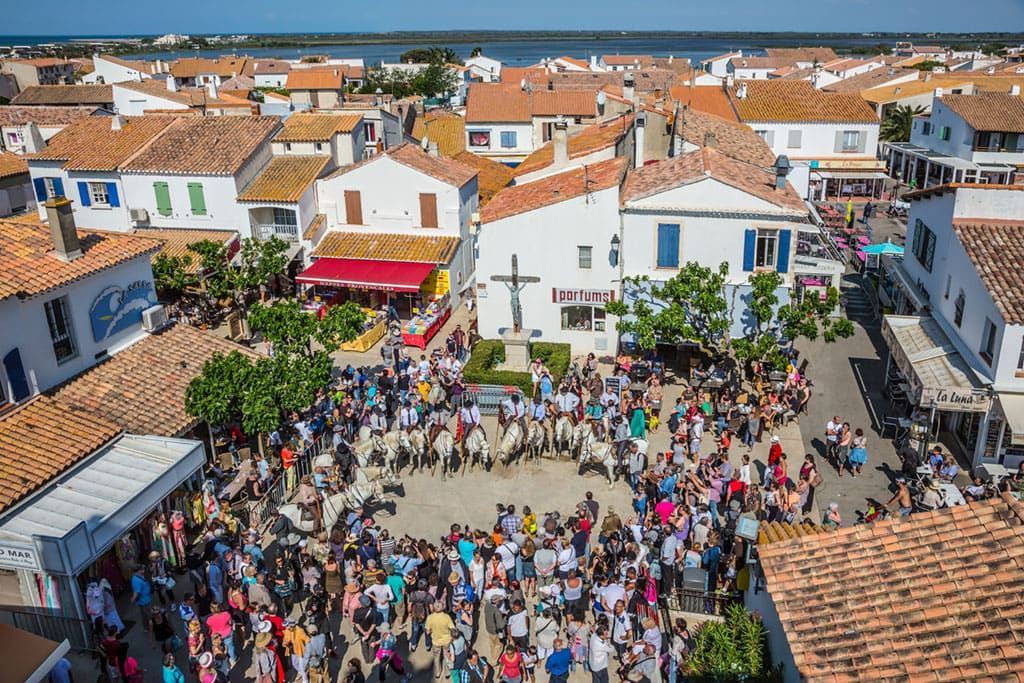Introduction to Saintes-Maries-de-la-Mer & Saint Sara La Kali
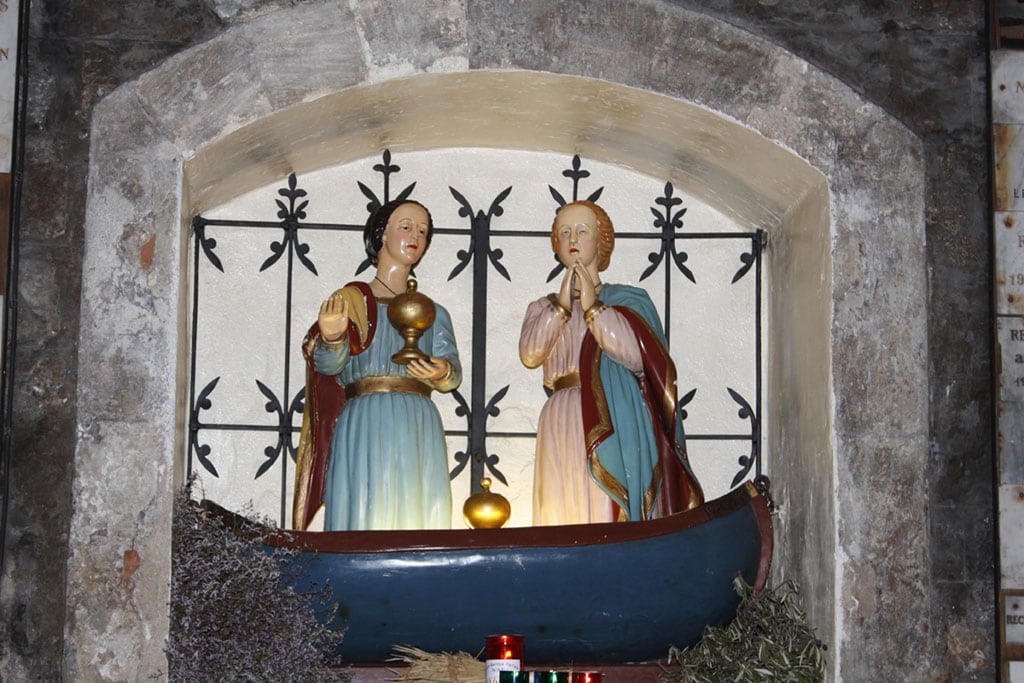
This article is a linked article; please read the article, Mary Magdalene, first.
Translations from the original French source material are made available in the English language for the first time regarding Saint Sara and the other patron saints and their sea journey by boat to the town Sainte-Maries-de-la-Mer in the south of France. Thousands of gypsy communities (Gitans, Manouches, Tsiganes) and their children flock to celebrate a festival dedicated to Saint Sara for many days every May in this beautiful French Mediterranean region of Camargue. Hopefully, after reading the linked article about Mary Magdalene, the reader will now realise the complexity of the subjects we try to cover.
Outdated Information
The book of Etienne Michel Faillon has outdated information but is still the basis for all those who claim to be Desposyni, who seek the tomb of Jesus and Mary Magdalene in Provence or the town of Rennes-Le-Château. His erudition is excellent, but he ignores textual criticism. He defends his church and beliefs more than historical truth or historical fact. In the 20th century, a new era of research developed a scientific methodology to study religious history.
The Last Historian who worked on the history of the Holy Legends of Provence is Eugène H Duprat (1872-1949); he makes the last answer to the hypotheses of Etienne Michel Faillon by demonstrating that Provençal religious traditions are neither historical nor apostolic. There was never Marie Magdala/Mary Magdalene, Marie Jacobé/Mary Jacob, Marie Salomé/Mary Salome, Lazarus, or Martha in Provence, France. Eugène H. Duprat, « Histoire des Légendes Saintes de Provence », dans Mémoires de l’Institut historique de Provence, t. XVII, 1940, p. 118 à 198.“
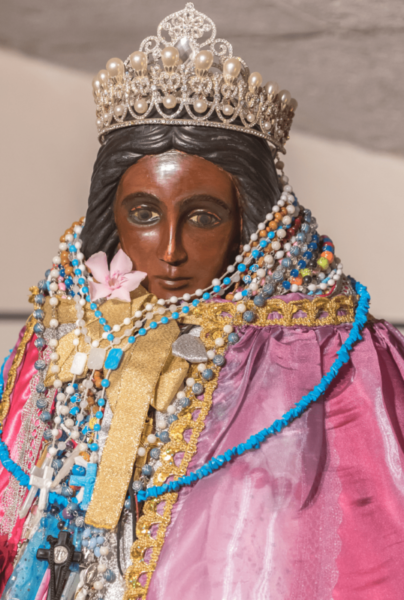
The Legend of the Saints That Came to Shore on a Boat
The legend of the beach landing and arrival of the Saint Maries, Sara, Lazarus, Maximin, and Sidon), possibly even the body of Jesus) who arrived from the Holy Land by sea as far as Gaul on a boat in Provence, France, ended in the 17th century. Jean de Laumoy (1603-1678), a doctor of Sorbonne, published the review of this tradition in 1641, Dissertatio de commentatio Lazari and Maximini, Magdalenea and Marthae in Provinciam appulsu.
Therefore, the foundation of the Church of Gauls and the Episcopal seats from these saints who arrived in Provence, France, will be totally questioned and seen as falling under Hagiographic myths. This is a severe attack on the Catholic Church and, in particular, its establishment in Provence. There will therefore be a response and a counter-response to this criticism. See Pinto-Matthieu Elisabeth, Marie Madeleine dans la littérature du Moyen Age, Editions Beacuchesne, Paris, 1997, pp.8-9.
Etienne Michel Faillon (1799-1872) is the most widely used author to promote the existence and coming of Palestinian saints in Provence, France. The book of Etienne Michel Faillon answers John de Laumoy’s criticisms. Monuments inédits sur l’apostolat de sainte Marie-Madeleine en Provence, et sur les autres apôtres de cette contrée: saint Lazare, saint Maximin, sainte Marthe, les saintes Maries Jacobé et Salomé, etc.“
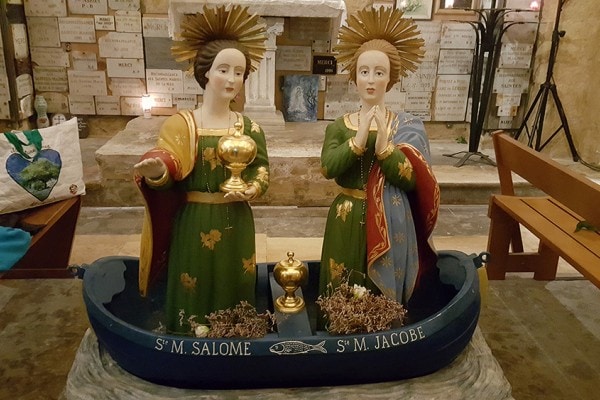
The Myth Starts With Saintes-Maries-de-la-Mer
The church houses two statues of two white Saint Marys and the black Saint Sara in the present day. Fernand Benoit, who was the first historian to decipher this folklore, underlines that as for Marie Jacobé, Marie Salomé and Marie Magdeleine, it is a procession to the sea that the Bohemians (also the Gypsies) have been doing since 1935. It precedes that of the Maries by one day, and the statue of Sarah is submerged to the waist.
These processions to the sea are simply a practice of immersing relics; it is linked to the agrarian and purifying processions preserved for us by the “festivals of Rogations and Carnival”- Fernand Benoit, La Provence et le Comtat Venaissin, Popular Arts and Traditions. This historian emphasizes that these processions to the sea participate in the very character of Provençal civilization and its respectful fear of the Mediterranean since they are found both in Saintes-Maries-de-la-Mer and in Fréjus, Monaco, Saint-Tropez or Collioure, linked to other saints. Fernand Benoit, op. Cit, p. 250-252.
Vive Sainte Sara
The plaster statue is modern, with the first procession invented by the Marquis of Baroncelli in 1935 to develop his Guardian festival.
From the 1850s to the 1950s, several laws attempted to prohibit the presence of gypsies in Saintes-Maries-de-la-Mer. It was finally, thanks to the intervention of a Camargue marquis, Baroncelli, a fervent defender of the gipsies, that they were accepted. Baroncelli believed that this unique pilgrimage had the power in itself to boost tourism in Saintes-Maries-de-la-Mer.
As King René did at another time, Baroncelli saw this event as an opportunity for dynamism in Saintes-Maries-de-la-Mer and is therefore committed to ensuring that the cult of the Black Sara was recognised as such in the midst of traditional Provençal Catholic cults.
The May Festivals
It is possible to sequence the transformations of the May festivals in Saintes-Maries-de-la-Mer into three successive periods.
1: The nineteenth century and the Catholic reconquest Relying on the invention of relics, the Church intended to reaffirm the Catholicity of the place and promote the development of the religious manifestations that took place there.
Widening the audience of the pilgrimage requires strengthening its organization; Popular, even populous ceremonies – “You can also see bohemians there” [Lamoureux, 1909], require being able to welcome members of other social classes: in 1873, the parish priest of Saintes-Maries-de-la-Mer installed stands in the church. Remaining in place for a century, they offered paid places, even numbered at certain times, guaranteeing both a good view of the ceremonies and respect for social hierarchies [Carrière, 1979: 118].
From 1892, the arrival of the train at Saintes-Maries-de-la-Mer simplified access to the village; the times of the ceremonies adapted to this new reality, the time of the ceremonies being a function of the train times [Mazel, 1935: 153-154]. During the twentieth century, the Church made other modifications [Causse, 2001] according to the constraints or the needs of the cult. Bordigoni Marc, « Le « pèlerinage des Gitans », entre foi, tradition et tourisme », Ethnologie française, 2002/3 (Vol. 32), p. 489-501. DOI: 10.3917/ethn.023.0489.
2: The first half of the twentieth century and Felibre innovation. At a time when the municipal council of Saintes-Maries-de-la-Mer was worried about finding resources and news for the town, Frédéric Mistral created a movement called the Félibrige in 1854, and when he joined the Society of National Ethnography and Popular Arts, he specified the vocation of his movement.
Development through poetry and popular manifestations.
The resurgent Occitan literary movement was associated with Frédéric Mistral. A close friend of Mistral was the Marquis de Baroncelli-Javon, who provided the Arlaten museum. It was founded by the writer, with a few Camargue objects, feeling that “the work [of Félibre is] poorly supported by the public in Provence [ …] [Retired] to his farmhouse in Amarée […] appearing with his faithful companions at all the southern festivals” [Ripert, 1924: 148-149]. Bordigoni Marc, « Le « pèlerinage des Gitans », entre foi, tradition et tourisme », Ethnologie française, 2002/3 (Vol. 32), p. 489-501. DOI: 10.3917/ethn.023.0489.
The Marquis of Baroncelli had another passion: The defence of minorities.
Another passion resides in him, the defence of minorities – in particular, the Indians of North America, then those he considers to be their European brethren, the Gypsies. The meeting, in 1905, with William Cody, who came to present his Buffalo Bill Wild West Show in Nîmes, is decisive because it allowed him to meet an Indian chief, Chief Philip Blue Shield, with whom he will maintain a regular correspondence.
This ‘leads to the construction of an astonishing theory “based” on a linguistic-anthropological comparativist: “Atlantis disappears. But burrs of the race that populated it remains on both sides. The Red Skin […] is identified. […] Four debris, four tribes of the Atlantean race, remained on the European or African edges of the abyss […]: the Basques and the Celts, the Egyptians and the Gypsies” [Baroncelli-Javon, 1910: 16-17].
This is not the place to analyse Baroncelli’s though; it is important to understand that it is in this context that he reflects on the gypsy question and that he intervenes in 1935 so that the Church authorizes a procession of Sara to the sea so that the Gypsies have their full place at the May celebrations. Catholic and Provencal Bordigoni Marc, « Le pèlerinage des Gitans », entre foi, tradition et tourisme », Ethnologie française, 2002/3 (Vol. 32), p. 489-501. DOI: 10.3917/ethn.023.0489.
There were no gypsies before that time. It is a full French tourism affair for regional development and political regionalism against the north of France and Parisians representing the state government wanting to kill regional traditions (they wanted to create a full, common education system with one common language: French, and not different regional languages.
3: The second half of the twentieth century and the “gypsy” affirmation At the heart of the city of Saintes-Maries-de-la-Mer is the “Place des Gitans”: it is one of the places where stationed, and still do, a few nomadic families at the time of the May celebrations. Has this presence of the Gypsies always been “obvious”?
As ancient as the pilgrimage to Saintes-Maries-de-la-Mer may be, the presence of the Bohemians is only attested in the mid-nineteenth century. Historian G. Gangneux notes that “all our documentation in these two centuries (seventeenth-eighteenth) never mentions Sarah the Egyptian, nor a fortiori of any gypsy procession” [1988: 26]. Surely more interesting than the question of the presence of the first Bohemians in Saintes-Maries-de-la-Mer is this: from when and why the Bohemians became visible.
The parish archives do not “see” any more Bohemians: “… In the parish archives, no document suggests, before the beginning of the nineteenth century, a membership of the gypsy race; and the first ones that attract attention are dubious, to say the least “[Colinon, 1975: 56-57]. Carrière [1979: 120] also indicates that he found no mention of it in “the precious notebook written by the parish priest Escombard”, who was parish priest of Saintes-Maries-de-la-Mer from 1861 to 1893.
The mere presence of boumians (bohemians) in the middle of a popular pilgrimage, Provençal, and Languedoc, has become, through the initiatives of Folco de Baroncelli, a procession of “Gypsies” and their “patron saint”. But the Marquis, in his constant concern for “races” and “origins”, made a clear distinction between the “Gypsies”, descendants of the first occupants of the Camargue and the “Bohemians”, nomadic peoples from the East. Before the war, the Provençal clergy, whose links with the Félibréen movement were important [Martel, op. Cit.], supported these efforts.
After the war, priests set up a “national Gypsy chaplaincy” because, in their minds, the Baroncellian distinction has no meaning, the word “gypsy” covering all the realities of nomadic families or “from nomads as the Administration said at the same time. Their concern for evangelization leads them to come to Saintes-Maries-de-la-Mer with the families they frequent daily, gypsies, Roma or Yeniche. The pilgrimage becomes a national pilgrimage for all Travelers.
The plaster statue is not old, and the first procession was in 1935, invented by the Marquis of Baroncelli to develop his Guardian festival.
In 1935, the Marquis de Baroncelli and a few Guardians of the Camargue, anxious to give the Gypsies in the Pilgrimage a place which they did not have, “at that time they were only a few hundred, lost in the great crowd of pilgrims of Provence and Languedoc, France”. They organized with the Gypsies of the region this march towards the sea in memory of the arrival of “their Saint”.
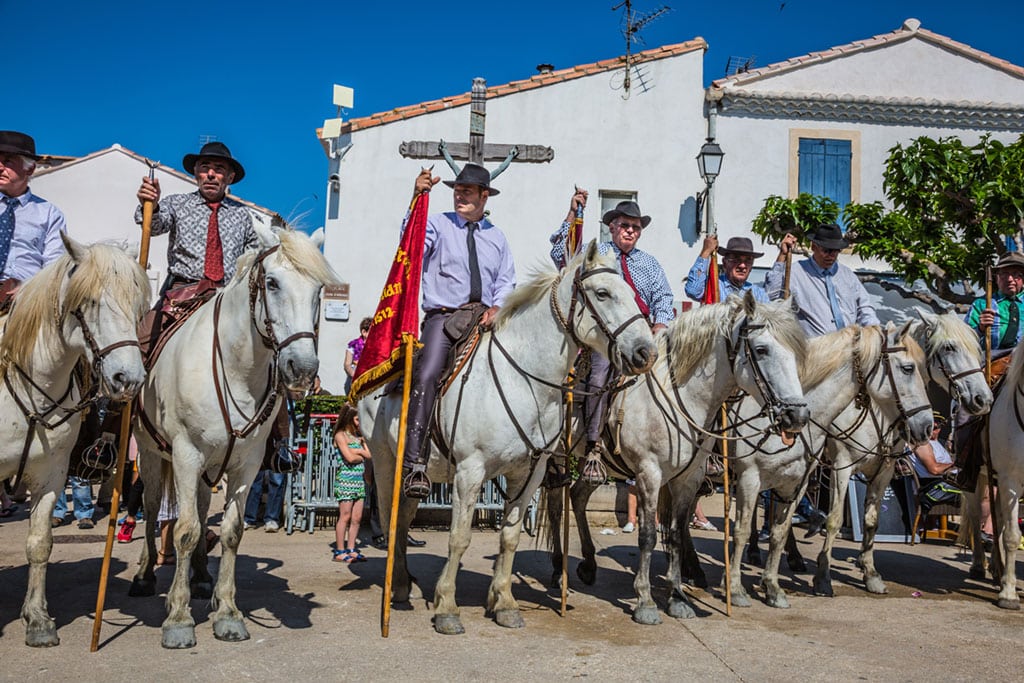
The Invention of the Statue of Sara
What is Camargue famous for?
Some documents would attest to an old devotion to a Saint Sarre or Sara (Delage: 12), but more certainly, a historian, having two centuries of municipal town archives of Saintes-Maries-de-la-Mer, writes Document Bordigoni 04/07/052 “All our documentation in these two centuries (17th-18th century) never mention Sara/Sarah the Egyptian, nor a fortiori of any gypsy procession ” (Gangneux 1988: 26).
The procession of Sara to the sea was instituted in 1935 under the leadership of Folco de Baroncelli. So, you can imagine this ceremony being inspired by the procession to the sea of the boat carrying the statue’s of Marie Jacobée and Marie-Salomée; a statue of Sara needed to exist. But when did she appear? In the 19th century, and the fortiori before, we are not aware of any document attesting to the presence of a statue of Sara in the crypt or elsewhere in the church.
There is indeed a “reliquary” containing human bones in the crypt, but this “non-consecrated place” (Delage: 19) was used to store objects of all kinds, carved stones, old altar, votive offerings, etc., before undergoing various rearrangements as and when increased attendance.
All the authors called to testify describe the statues of Saintes Maries in their boat; why would they all ignore the description of Sara’s statue if they had seen it? Yet she will be there in 1935 to go to the sea, accompanied by the Nacion Gardiano of the Marquis de Baroncelli-Javon.
During my various stays in Saintes-Maries-de-la-Mer, I did not meet anyone able to remember the dates of the presence of the statue of Sara. Just as astonishing as the absence of local memory is the constitution of Sara; Delage testifies: “However, I have had the opportunity to examine it in detail for the first time, during an accident that occurred during the procession to the sea, and which obliged me to redo during the night all the lower part of the statue and, quite recently [he wrote in 1955], during the moulding that I have executed.
As has been sometimes indicated, this statue in plaster and not in wood is not at all old. It must have, in my opinion, replaced a much older wooden statue. The statues of the Church of Saintes Maries are; moreover, almost all made of wood, but when and on what occasion?” (Delage 1956: 29-30)
On the contrary, everything seems to indicate that there has never been an ancient statue of Sara. But around the 1930s, against the church: “on the other side (seaside) the fairgrounds have settled. (…) They sell everything to do with pilgrimages, rosaries, medals, pious charms etc.” (Vaudoyer 1927: 41-42). It would not be surprising that among these merchants and (gypsies), there was one able to donate these plaster statues that some merchants were selling at the end of the 19th century. Or, more exactly, two pieces (a head and a body of different scales) someone had the idea to compose a holy Sara! All were invented in 1935. Marc Bordigoni. Sara aux Saintes-Maries-de-la-Mer. Métaphore de la présence gitane dans le ”monde des Gadjé”. Etudes Tsiganes, Fédération nationale des associations solidaires d’action avec les Tsiganes et les Gens du voyage, 2005, pp.12-34.
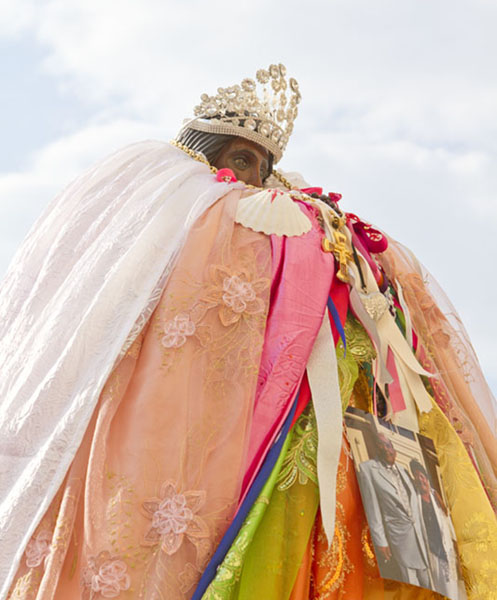
Kali, India and Egypt
There are two separate legends regarding Sara, one a catholic legend and the other a gypsy legend. The gypsy legend has Sara already living in the Camargue region of France when the “Saint Marys” arrived. The gypsies arrived in this region in the 15th century, so as you can see, there is a massive problem!
The following theory is now accepted for the origin of the Roms and Gypsies, etc.; it is that of India due to the study of their language; 80% of their words come from Northern India. The legend of the Saint Marys, Martha and her servant called Sara, was to be used by the gypsies; it has a connection with India, not Egypt.
The confusion with Egypt stems from the term “Gypsy.”
In the 9th century, Gypsies arrived in Greece and conquered the Peloponnese near Mount Gype. It is the Italians who will call this part of Greece the “Little Egypt” and their egyptiano inhabitants. The Gypsies are, therefore, by no means from Egypt; they are Indo-Europeans and would have left India around the year 1000. The Peloponnese will be the transit region of these people. Before that, they will cross Nicomedia, which the Turks call “Little Egypt” in Asia Minor (Turkey) because of its fertility and its heavenly appearance, according to Hungarian Gypsyologist Anton Hermann, who himself is a Tzigane gypsy.
There is no Connection Between African Egypt and the Cult of Isis
The term Gypsy comes from the Greek Athinganos and means “he who does not want to touch or be touched.” This is the characteristic of the outcasts or “untouchables” from India. For ethnologists, they come from Brahmanic India with Indo-Iranian variations and different occupations of the untouchables as butchers, scavengers, gravediggers, garbage collectors, rags-pickers, ironworkers, mercenaries and saltimbanques (itinerant circus performers). Their origin comes more from trade classes than from race. They were forbidden to be sedentary.
Another Baltic Gypsy researcher, Jean Kochanowski, claims an origin for his group of Northwest India belonging to the high Castes of military and aristocratic India originating from Delhi. The debate is not closed for the various “Roma” groups. Fortunately for us, linguistics allows us to connect them with the Doms or Domba of India, who were commercial nomads who still live in northern India, a proto-history in Uttar-Pradesh.
It is strange for me to see women refer to the tradition of Sara and gypsies to defend a form of women’s rights or worship related to or supposedly related to Kali because a book would have indicated Sara the Kali to mean Sara the Black or the Gypsy. In fact, rather than Kali, it is Khale or Kale, from the Romanian Kalderash (boilermakers, metallurgists) in the Iberian Peninsula.
Conclusion From Kale to Kali
This step of Kale to Kali has no historical value and, as we have read from the experts, has no link to a procession of a Christian Black Virgin who sits on a throne with the child Jesus sitting on her knee. The Roma play claims to be descended from Rama, Ramachandra, Tubalcain, Aztecs, Mayas, the great Mongol, etc., and also now from Mary Magdalene. The myth of the Female Divine among the outcasts or even the Upper Caste is easily destroyed by the situation of women in India.
This is even more because of the situation of women in this environment of marriage to give birth and stay at home, the test of the handkerchief to verify virginity as public proof, the agreement of families, and the “patriarchal” influence. This connects with the Domba tradition of India. Sara will be the first Christian and will be able to wear the tiara. The “tradition” was established in 1935 for the ultimate tourist interest, to maintain the “gypsy’s festival.
